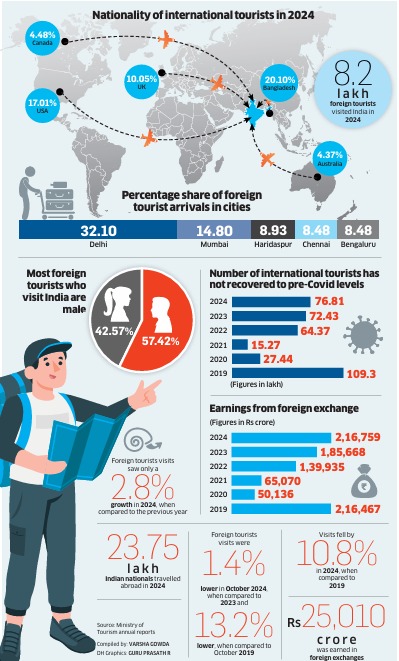Context:
World Tourism Day is celebrated on 27 September, a day designated by the United Nations to highlight the social, cultural, economic and environmental importance of tourism. The date commemorates the adoption of the Constitution of the United Nations World Tourism Organization (UNWTO) in 1970, which was an important milestone for global tourism cooperation. World Tourism Day was first officially celebrated in 1980. Since 1997, a host country has been selected annually. This year, the official celebrations and the World Tourism Summit are being held in Malacca, Malaysia, from 27 to 29 September 2025.
-
- The theme of World Tourism Day 2025 is “Tourism and Sustainable Transformation”. The aim is to transform tourism into a vehicle for inclusive, climate-conscious and resilient transformation, not just recovery from crises (such as the COVID-19 pandemic).
- As the world grapples with complex challenges like climate change, over-tourism, and socio-economic inequalities, India stands at a crucial juncture where tourism can become a powerful tool for sustainable development. With its rich cultural heritage, diverse geographical landscape, and centuries-old legacy, India holds a unique place on the global tourism map. From the snow-capped peaks of the Himalayas to the tranquil backwaters of Kerala, from ancient temples and bustling markets to modern urban centers—the country's diversity and vastness attracts millions of domestic and international tourists every year.
- The theme of World Tourism Day 2025 is “Tourism and Sustainable Transformation”. The aim is to transform tourism into a vehicle for inclusive, climate-conscious and resilient transformation, not just recovery from crises (such as the COVID-19 pandemic).
Tourism in India: Current Status and Growth Trajectory:
-
- Tourism contributed 5% to India’s GDP in FY23 and supported 7.6 crore jobs across direct and indirect channels. According to the Ministry of Tourism, foreign tourist arrivals (FTAs) reached approximately 1 crore in 2024, recovering from the post-pandemic slump. Foreign exchange earnings from tourism crossed $28 billion in 2023, reaffirming its economic significance.
- India currently ranks 14th globally in tourism receipts and attracts only 1.45% of the world’s international tourists. In contrast, global tourism giants like France, Spain, and Thailand draw many times that number.
- What makes India stand out, however, is its robust domestic tourism market. Indians took over 2 billion domestic trips in 2023 alone, making internal tourism a powerful driver of demand, infrastructure development, and cultural exchange.
- Tourism contributed 5% to India’s GDP in FY23 and supported 7.6 crore jobs across direct and indirect channels. According to the Ministry of Tourism, foreign tourist arrivals (FTAs) reached approximately 1 crore in 2024, recovering from the post-pandemic slump. Foreign exchange earnings from tourism crossed $28 billion in 2023, reaffirming its economic significance.
What Makes India a Unique Tourism Destination:
India’s competitive advantage in tourism stems from its diversity—geographical, cultural, spiritual, and medical. This allows the country to cater to multiple market segments at once.
Key pillars of India’s tourism offering include:
-
- Spiritual and cultural heritage: With sites like Varanasi, Amritsar, Hampi, Ajanta-Ellora, and the Char Dham circuit, India is a global magnet for spiritual tourism. The Ramayana Circuit and Buddhist Circuit are now being actively promoted under the Dekho Apna Desh campaign.
- Medical and wellness tourism: India offers high-quality, low-cost medical procedures in cities like Chennai, Delhi, and Mumbai, attracting patients from West Asia, Africa, and Southeast Asia. Wellness resorts in Kerala and Uttarakhand offer Ayurveda and Yoga, adding a traditional dimension to modern care.
- Nature and adventure: From the Himalayas to the Western Ghats, from the Rann of Kutch to the Sundarbans, India’s biodiversity hotspots offer trekking, wildlife safaris, river rafting, and ecotourism.
- Events and MICE tourism: With improved convention centres and upgraded airports, India is positioning itself as a hub for meetings, incentives, conferences, and exhibitions (MICE). G20-related tourism in 2023–24 showed India's capacity to host large global gatherings.
- Spiritual and cultural heritage: With sites like Varanasi, Amritsar, Hampi, Ajanta-Ellora, and the Char Dham circuit, India is a global magnet for spiritual tourism. The Ramayana Circuit and Buddhist Circuit are now being actively promoted under the Dekho Apna Desh campaign.
Challenges:
Despite its vast potential, India’s share in global tourism remains small. Several structural challenges continue to hamper growth:
-
- Inadequate last-mile connectivity: Many tourist destinations lack proper roads, railways, or direct air access. This limits access to remote and emerging destinations.
- Safety and hygiene concerns: Cleanliness, public toilets, and women’s safety remain persistent issues, particularly in rural and semi-urban destinations.
- Visa and entry barriers: High visa costs, lack of group tourism facilitation, and complex e-visa procedures are major deterrents for foreign travellers.
- Skilling gaps in hospitality sector: Lack of trained staff in tourism-facing roles—such as guides, hotel workers, and interpreters—leads to inconsistent visitor experience.
- Underdeveloped digital infrastructure: Tourists expect seamless digital experiences—from booking and navigation to payments and reviews. Many Indian destinations still lack robust digital integration.
- These issues not only impact tourist satisfaction but also affect India’s global ranking in the Travel and Tourism Development Index (TTDI), where it was ranked 54th in 2021.
- Inadequate last-mile connectivity: Many tourist destinations lack proper roads, railways, or direct air access. This limits access to remote and emerging destinations.
Government Interventions and Policy Push:
Recognising tourism’s transformative potential, the government has launched multiple schemes and initiatives to scale up the sector.
-
- Swadesh Darshan 2.0: Focuses on sustainable and theme-based tourism infrastructure development in 50 destinations.
- PRASHAD Scheme: Aims to improve infrastructure at religious heritage sites with a focus on spiritual tourism.
- UDAN Scheme: Enhances regional air connectivity to tier-2 and tier-3 cities, unlocking new tourist circuits.
- Dekho Apna Desh: A campaign to promote domestic travel and awareness, with financial incentives for group travel and state-level competition.
- Swadesh Darshan 2.0: Focuses on sustainable and theme-based tourism infrastructure development in 50 destinations.
In addition, states like Gujarat, Kerala, and Madhya Pradesh have crafted their own tourism policies focused on eco-tourism, heritage hospitality, and cinematic tourism.
The Vision for 2047: India as a Global Tourism Powerhouse
The government’s 2047 vision includes doubling the tourism sector’s contribution to GDP and creating 15 crore tourism-related jobs. Key priorities for realising this include:
-
- Digital-first tourism services: Universal adoption of digital booking, multilingual virtual guides, and AI-based tourist assistance.
- Infrastructure overhaul: Better roads, rail, and air connectivity; clean toilets; and smart signage across tourist circuits.
- Visa liberalisation: Expanded visa-on-arrival and multi-entry group visas to make India more tourist-friendly.
- Strategic branding: A unified, consistent “Incredible India” campaign with stronger international outreach through embassies, festivals, and social media.
- Community-based tourism: Empowering local communities and SHGs to manage homestays, eco-guides, and cultural events for inclusive growth.
- Digital-first tourism services: Universal adoption of digital booking, multilingual virtual guides, and AI-based tourist assistance.
Conclusion:
As the world grapples with challenges such as climate change, inequality, biodiversity loss and cultural erosion, the tourism sector must actively be part of the solution. India, in particular, needs to ensure that tourism growth is balanced and equitable. When tourism becomes regenerative rather than extractive, it can strengthen livelihoods, preserve cultural identities, and become the foundation of climate resilience.
|
UPSC/PCS Main Question - |








